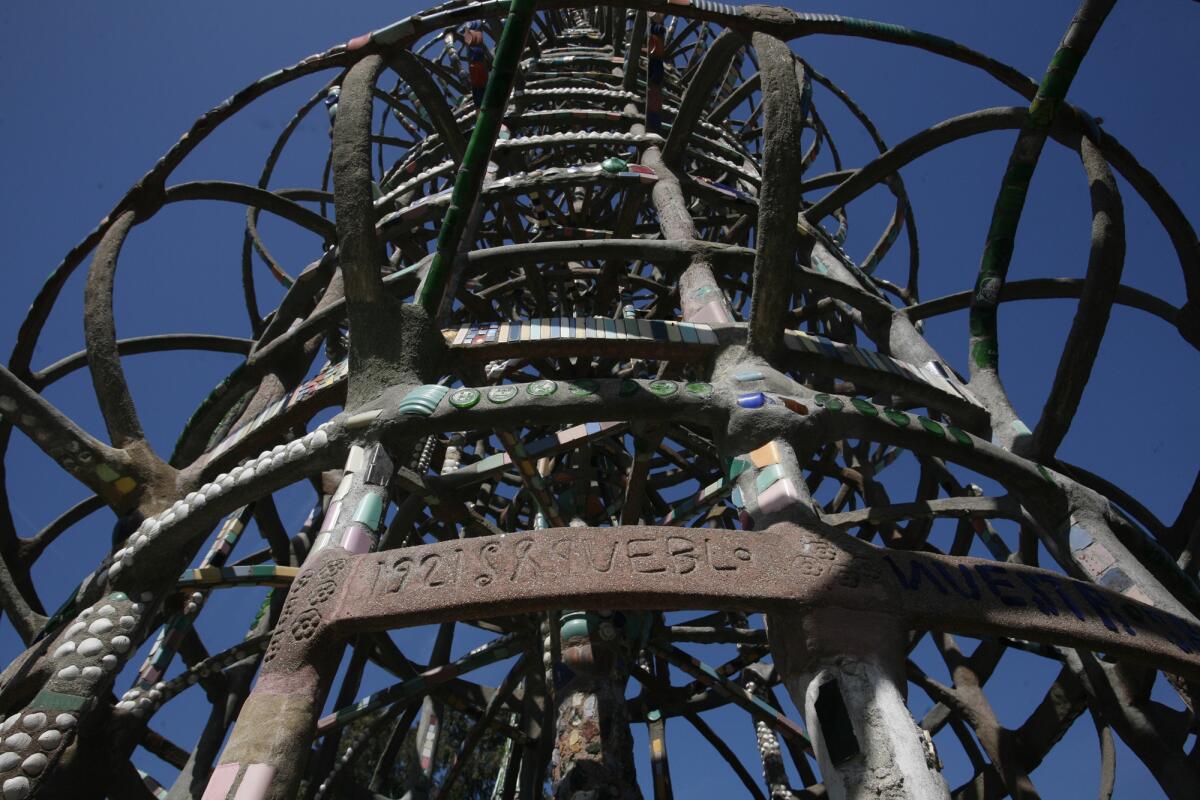Can a Frank Gehry design help change the dynamic of Watts?

- Share via
He is putting the finishing touches on an elegant new museum in Paris. He has created a demure renovation plan for the nearly century-old Philadelphia Museum. And Michael Govan, the director of the L.A. County Museum of Art, has floated his name for a possible tower at the intersection of Wilshire and Fairfax. The architecture of Frank Gehry is everywhere. But most significantly, it’s about to land in Watts.
Gehry Partners has signed on to design a campus for the Children’s Institute, Inc. (CII), a social services not-for-profit that provides youth development and education programs, as well as other family support and clinical services. For the project, the firm is collaborating with (fer) studio of Inglewood.
The new campus will occupy a 2-acre lot on East 102nd Street near its intersection with Compton Avenue. It is just a half-dozen block walk to the northwest of the Watts Towers.
All of this may seem small potatoes for Gehry, but the architect has been involved in nonprofit design projects in the past — such as Jazz Bakery in Culver City (in need of a capital campaign) and Brad Pitt’s Make It Right Foundation project in New Orleans (built in 2012).
“Our firm is always interested in projects which can help give back to our local community here in Los Angeles,” said Gehry’s firm in a statement. “We believe in CII’s mission and their goals for reaching and helping children and families in the community of Watts.”
In recent years, new construction, such as the Dolores McCoy Villa on South Firth Avenue, spearheaded, in part, by the Watts Labor Community Action Committee, have improved housing options in the area. But the CII project, says the organization’s executive vice president Nina Revoyr, has the potential to introduce something fresh.
“We’re not going to build Disney Hall in the middle of Watts,” she says. “But that being said, the idea is that this will be something special. There are so many messages that people, particularly children, get from their environment. There can be a certain bleakness.”
The CII building program is still in the planning stages and the design process has yet to really begin, so there are currently no costs attached. (CII estimates that a design will be in place by the end of this year, with construction slated to begin in late 2016.) Revoyr says that they’re looking to budget around $22 million for construction.
CII isn’t releasing figures on fund-raising, since budgets have yet to be finalized, but Revoyr says they are ahead of schedule on the money front: “We already have seven-figure commitments.”
If all goes according to plan, Gehry’s building will represent an intriguing architectural addition to Watts, a neighborhood best known for being home to the iconic Watts Towers — as well as some pretty dour institutional architecture.
Though Watts retains many charming 1920s bungalows and Art Deco storefronts, it is also studded with numerous 1940s public housing projects built in an austere barracks style. The infamous Jordan Downs has been slated for a desperately needed revamp, but the project has been plagued by money problems and toxic waste. Various other public housing projects in the vicinity — such as Nickerson Gardens — face issues of maintenance, gang violence and an architecture that is downright grim.
Many of the government buildings in Watts are on the brutal side. And schools and other institutional buildings, even when they might retain some architectural grace, are often wrapped in layers of bars, chain link and barbed wire.
“I think having a building by Frank Gehry will give kids a message about beauty,” says Revoyr. “It shows them that there is something different. That there is a larger world.” A building, ultimately, that shows them respect.
On Monday, I toured the area around the Watts site with Revoyr, as well as Jacqueline Atkins, a psychologist who serves as CII’s regional vice president of programs. Atkins was raised in Watts, in the immediate vicinity of the CII site.
I asked her whether she thought the design of a single building really had the power to influence this troubled neighborhood’s dynamic. She says she thinks it might.
“When I was working on my dissertation, I went back to Markham, my middle school,” she recalls. “There were bars on all the windows and you had to get buzzed in and buzzed out. It was very severe. But it wasn’t until I left Watts to go to college that I even noticed this. I didn’t realize that this isn’t the way things are supposed to be, that this isn’t the way most people live.”
“These are the kinds of things that tell you about your worth,” she adds. “Your environment gives you a sense of how much you matter and how much you don’t. That’s why kids act out. They want to matter. They want to be seen. An investment like this — from CII, from Gehry, from others — it’s about having a place where you feel seen.”
For Gehry’s firm, the scale of this project may be small. But in some respects it’s as important as anything he’s built in Bilbao.
Twitter: @cmonstah
More to Read
The biggest entertainment stories
Get our big stories about Hollywood, film, television, music, arts, culture and more right in your inbox as soon as they publish.
You may occasionally receive promotional content from the Los Angeles Times.











